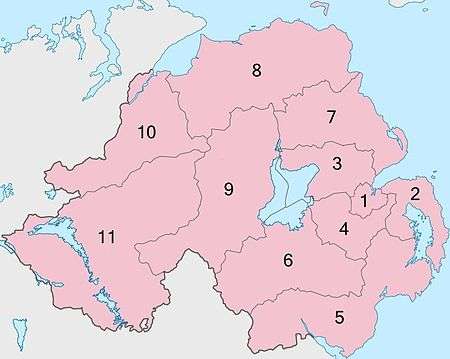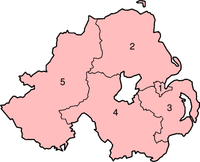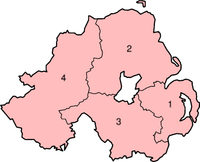Local government in Northern Ireland
 |
|---|
| This article is part of a series on the politics and government of Northern Ireland |
a Lowercase "d" per here. |
|
Northern Ireland in the EU |
Northern Ireland is divided into 11 districts for local government purposes. In Northern Ireland, local councils do not carry out the same range of functions as those in the rest of the United Kingdom; for example they have no responsibility for education, road-building or housing (although they do nominate members to the advisory Northern Ireland Housing Council). Their functions include planning, waste and recycling services, leisure and community services, building control and local economic and cultural development. The collection of rates is handled centrally by the Land and Property Services agency of the Northern Ireland Executive.
Local Government Districts

| District | Council | Meeting place | Population[1] | № on map |
|---|---|---|---|---|
| Antrim and Newtownabbey | Antrim and Newtownabbey Borough Council | Newtownabbey and Antrim (alternately) | 141,700 | 3 |
| Ards and North Down | Ards and North Down Borough Council | Bangor | 160,100 | 2 |
| Armagh City, Banbridge and Craigavon | Armagh City, Banbridge and Craigavon Borough Council | Craigavon | 211,900 | 6 |
| Belfast | Belfast City Council | Belfast | 340,200 | 1 |
| Causeway Coast and Glens | Causeway Coast and Glens Borough Council | Coleraine[2] | 143,900 | 8 |
| Derry and Strabane | Derry City and Strabane District Council | Derry | 150,500 | 10 |
| Fermanagh and Omagh | Fermanagh and Omagh District Council | Omagh and Enniskillen[3] | 116,300 | 11 |
| Lisburn and Castlereagh | Lisburn and Castlereagh City Council | Lisburn[4] | 142,600 | 4 |
| Mid and East Antrim | Mid and East Antrim Borough Council | Ballymena[5] | 138,200 | 7 |
| Mid Ulster | Mid Ulster District Council | Dungannon[6] | 146,400 | 9 |
| Newry, Mourne and Down | Newry, Mourne and Down District Council | Downpatrick and Newry | 179,000 | 5 |
Composition of District Councils
| District | DUP | SF | UUP | SDLP | APNI | TUV | PUP | Green | UKIP | Con. | PBP | Ind. | Total | |||||||||||||
|---|---|---|---|---|---|---|---|---|---|---|---|---|---|---|---|---|---|---|---|---|---|---|---|---|---|---|
| Antrim and Newtownabbey | 15 | 3 | 12 | 4 | 4 | 1 | 0 | 0 | 0 | 0 | 0 | 1 | 40 | |||||||||||||
| Ards and North Down | 18 | 0 | 9 | 1 | 7 | 1 | 0 | 2 | 0 | 0 | 0 | 2 | 40 | |||||||||||||
| Armagh City, Banbridge and Craigavon | 13 | 8 | 11 | 6 | 0 | 0 | 0 | 0 | 1 | 0 | 0 | 2 | 41 | |||||||||||||
| Belfast | 13 | 19 | 6 | 4 | 8 | 0 | 3 | 1 | 0 | 0 | 1 | 5 | 60 | |||||||||||||
| Causeway Coast and Glens | 12 | 7 | 8 | 6 | 1 | 3 | 1 | 0 | 0 | 1 | 0 | 1 | 40 | |||||||||||||
| Derry and Strabane | 7 | 16 | 2 | 8 | 0 | 0 | 0 | 0 | 0 | 0 | 0 | 7 | 40 | |||||||||||||
| Fermanagh and Omagh | 6 | 16 | 8 | 6 | 0 | 0 | 0 | 0 | 0 | 0 | 0 | 4 | 40 | |||||||||||||
| Lisburn and Castlereagh | 19 | 0 | 9 | 4 | 5 | 1 | 0 | 0 | 0 | 0 | 0 | 2 | 40 | |||||||||||||
| Mid and East Antrim | 16 | 2 | 9 | 1 | 3 | 4 | 0 | 0 | 2 | 0 | 0 | 3 | 40 | |||||||||||||
| Mid Ulster | 8 | 18 | 7 | 5 | 0 | 0 | 0 | 0 | 0 | 0 | 0 | 2 | 40 | |||||||||||||
| Newry, Mourne and Down | 4 | 14 | 3 | 14 | 2 | 0 | 0 | 0 | 0 | 0 | 0 | 4 | 41 | |||||||||||||
| TOTAL | 131 | 103 | 84 | 59 | 30 | 10 | 4 | 3 | 3 | 1 | 1 | 33 | 462 | |||||||||||||
Last updated 26 November 2017.[7]
History
The current pattern of 11 local government districts was established on 1 April 2015, as a result of the reform process that started in 2005.
The previous pattern of local government in Northern Ireland, with 26 councils, was established in 1973 by the Local Government (Boundaries) Act (Northern Ireland) 1971 and the Local Government Act (Northern Ireland) 1972 to replace the previous system established by the Local Government (Ireland) Act 1898. The system was based on the recommendations of the Macrory Report, of June 1970, which presupposed the continued existence of the Government of Northern Ireland to act as a regional-level authority.[8]
From 1921 to 1973, Northern Ireland was divided into six administrative counties (subdivided into urban and rural districts) and two county boroughs. The counties and county boroughs continue to exist for the purposes of lieutenancy and shrievalty.[9] This system, with the abolition of rural districts, remains the model for local government in the Republic of Ireland. (See also List of rural and urban districts in Northern Ireland for more details.)
Elections
Councillors are elected for a four-year term of office under the single transferable vote (STV) system. Elections were last held in May 2014. To qualify for election, a councillor candidate must be:
- at least 18 years of age, and
- a Commonwealth of Nations or European Union citizen.
In addition, he or she must either:
- be a local elector for the district, or
- have, during the whole of the 12-month period prior to the election, either owned or occupied land in the district, or else resided or worked in the district.
Combinations
The districts are combined for various purposes.
Eurostat NUTS level 3
In the Eurostat Nomenclature of Territorial Units for Statistics (NUTS), Northern Ireland is divided into five parts at level 3
| Name | Area | ||
|---|---|---|---|
| UKN01 | Belfast |  | |
| UKN02 | Outer Belfast | Carrickfergus, Castlereagh, Lisburn, Newtownabbey, North Down | |
| UKN03 | East | Antrim, Ards, Ballymena, Banbridge, Craigavon, Down, Larne | |
| UKN04 | North | Ballymoney, Coleraine, Derry, Limavady, Moyle, Strabane | |
| UKN05 | West and South | Armagh, Cookstown, Dungannon, Fermanagh, Magherafelt, Newry and Mourne, Omagh |
Former Education and Library Boards
There were five education and library boards (ELBs) in Northern Ireland.
As part of the Review of Public Administration process, the library functions of the ELBs were taken over by a new body, the Northern Ireland Library Authority (branded Libraries NI) in April 2009.[10]
The education and skills functions were centralised into a single Education Authority for Northern Ireland in April 2015. [11]
The boards were as follows:
| Name | Area | ||
|---|---|---|---|
| 1. | Belfast |  | |
| 2. | North Eastern | Antrim, Ballymena, Ballymoney, Carrickfergus, Coleraine, Larne, Magherafelt, Moyle, Newtownabbey | |
| 3. | South Eastern | Ards, Castlereagh, Down, Lisburn and North Down | |
| 4. | Southern | Armagh, Banbridge, Cookstown, Craigavon, Dungannon and South Tyrone, Newry and Mourne | |
| 5. | Western | Derry, Fermanagh, Limavady, Omagh, Strabane |
Former Health and Social Services Boards
There were four health and social services boards which were replaced by a single Health and Social Care Board in April 2009.[12]
The former health and social services boards were as follows:
| Name | Area | ||
|---|---|---|---|
| 1. | Eastern | Ards and North Down, Belfast, Lisburn and Castlereagh |  |
| 2. | Northern | Antrim and Newtownabbey, Causeway Coast and Glens, Mid and East Antrim | |
| 3. | Southern | Armagh, Banbridge and Craigavon, Mid Ulster, Newry, Mourne and Down | |
| 4. | Western | Derry and Strabane, Fermanagh and Omagh |
Reform
In June 2002, the Northern Ireland Executive established a Review of Public Administration to review the arrangements for the accountability, development, administration and delivery of public services. Among its recommendations were a reduction in the number of districts.[13] In 2005 Peter Hain, the Secretary of State for Northern Ireland, announced proposals to reduce the number of councils to seven.[14] The names and boundaries of the seven districts were announced in March 2007.[15] In March 2008 the restored Northern Executive agreed to create eleven new councils instead of the original seven.[16][17][18] The first elections were due to take place in May 2011. However, by May 2010 disagreements among parties in the executive over district boundaries were expected to delay the reforms until 2015.[19] In June 2010 the proposed reforms were abandoned following the failure of the Northern Ireland Executive to reach agreement.[20][21] However, on 12 March 2012, the Northern Ireland Executive published its programme for government, which included a commitment to reduce the number of councils in Northern Ireland to 11.[22]
See also
- List of districts in Northern Ireland by area
- List of districts in Northern Ireland by population density
- List of districts in Northern Ireland by religion or religion brought up in
- List of districts in Northern Ireland by national identity
- Political make-up of local councils in Northern Ireland
- ISO 3166-2:GB, subdivision codes for the United Kingdom
- Local government in England
- Local government in Scotland
- Local government in Wales
- Local government in the Republic of Ireland
Tables relating to the old 26 council system
References
- ↑ "Population Estimates for UK, England and Wales, Scotland and Northern Ireland, Mid-2017". Office for National Statistics. 28 June 2018. Retrieved 28 June 2018.
- ↑ "Contact Us - Causeway Coast & Glens Borough Council". www.causewaycoastandglens.gov.uk. Retrieved 19 March 2018.
- ↑ http://fermanaghomagh.public-minutes.com/
- ↑ "Contact - Lisburn Castlereagh". www.lisburncastlereagh.gov.uk. Retrieved 19 March 2018.
- ↑ "Archived copy" (PDF). Archived from the original (PDF) on 4 April 2016. Retrieved 23 March 2016.
- ↑ "Archived copy". Archived from the original on 19 March 2016. Retrieved 23 March 2016.
- ↑ "Open Council Data UK - Northern Ireland councils". opencouncildata.co.uk. Retrieved 2017-11-26.
- ↑ "Report of the Review Body on Local Government in Northern Ireland 1970. Chairman: Patrick A. Macrory, Esq. (Cmnd 546 )". CAIN Web Service – Conflict and Politics in Northern Ireland (University of Ulster). Belfast: HMSO. June 1970. Retrieved 16 September 2011.
- ↑ The Northern Ireland (Lieutenancy) Order 1975 (S.I. 1975 No.156)
- ↑ librariesni.org.uk – News, Campbell officially launches a new era in libraries Archived 29 October 2013 at the Wayback Machine.. Ni-libraries.net. Retrieved on 23 July 2013.
- ↑ http://www.eani.org.uk/
- ↑ "Homepage - HSCB". www.hscboard.hscni.net. Retrieved 19 March 2018.
- ↑ "Review of Public Administration". Northern Ireland Executive. Archived from the original on 17 September 2010. Retrieved 8 July 2010.
- ↑ "Major reform of local government". 22 November 2005. Retrieved 19 March 2018 – via news.bbc.co.uk.
- ↑ Revised Recommendations for new council boundaries unveiled, press release, 30 March 2007 Archived 7 February 2012 at the Wayback Machine.
- ↑ "NI councils reduced from 26 to 11". 13 March 2008. Retrieved 19 March 2018 – via news.bbc.co.uk.
- ↑ "NI councils reduced from 26 to 11". 13 March 2008. Retrieved 19 March 2018 – via news.bbc.co.uk.
- ↑ Foster announces the future shape of local government, NI Executive Archived 25 July 2008 at the Wayback Machine.
- ↑ "Plan to cut Northern Ireland councils may be delayed until 2015". Belfast Telegraph. 7 May 2010. Retrieved 24 May 2010.
- ↑ "The executive fails to agree a deal on council reform". BBC News. 15 June 2010. Retrieved 8 July 2010.
- ↑ "Local Government Association Incensed as Minister Stops the Reform Process". Northern Ireland Local Government Association. 15 June 2010. Archived from the original on 17 February 2011. Retrieved 8 July 2010.
- ↑ "Priority 5: Delivering High Quality and Efficient Public Services; Key Commitments" (PDF). Programme for Government 2011–15. Belfast: Office of the First Minister and deputy First Minister. 12 March 2012. Retrieved 15 June 2012.
External links
- NI Direct – Local Council Websites
- NI Local Government Association
- Review of Public Administration NI
- Local Government Boundaries Commissioner for Northern Ireland
- DOENI – Local Government
- Macrory Report
- Local Government (Boundaries) Act (Northern Ireland) 1971
- Northern Ireland Councillor's Handbook
- Map of the UK counties and unitary administrations
- Map of all UK local authorities